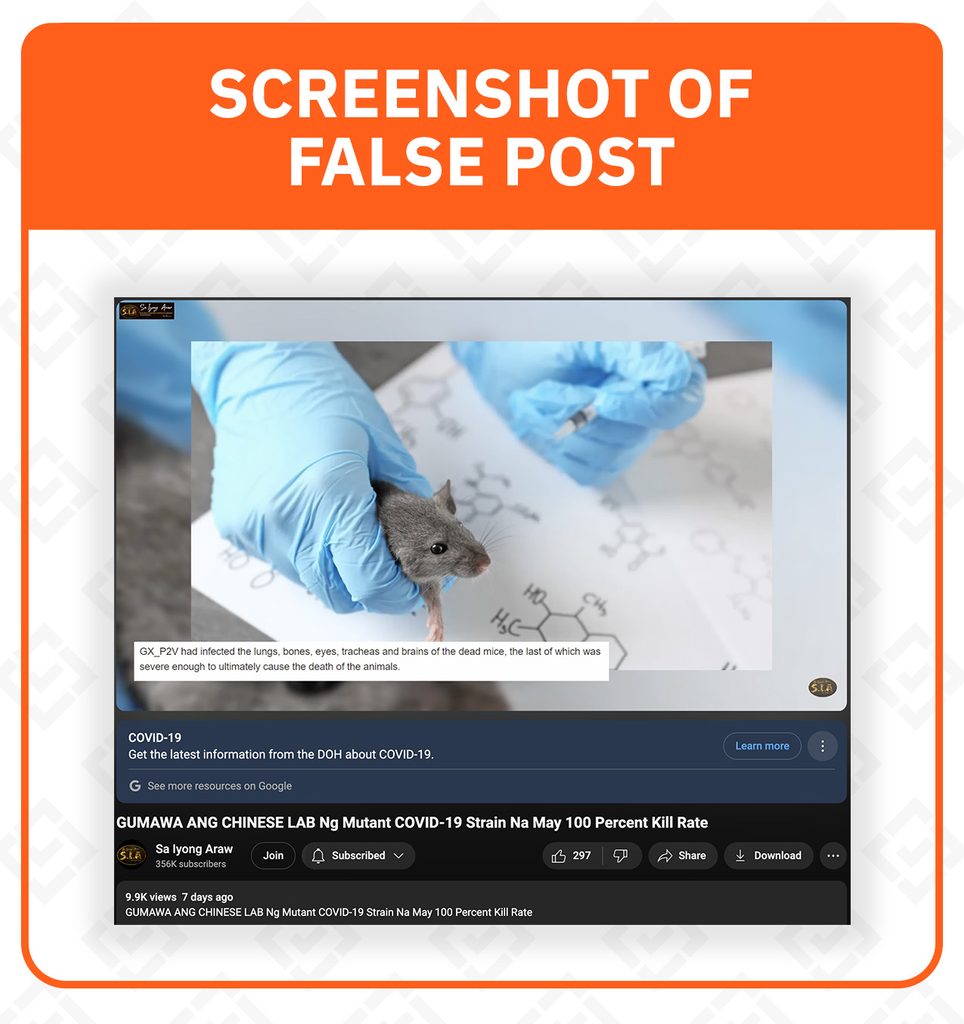SUMMARY
This is AI generated summarization, which may have errors. For context, always refer to the full article.

Claim: A Chinese lab developed a mutant COVID-19 strain with a 100% kill rate.
Rating: FALSE
Why we fact-checked this: The YouTube video was posted by a Philippine-based channel known for pushing anti-Chinese rhetoric. As of writing, the video has 9,938 views and 297 likes.
The title of the video bears the claim: “Gumawa ang Chinese lab ng mutant COVID-19 strain na may 100 percent kill rate” (A Chinese lab created a mutant COVID-19 strain with a 100% kill rate).

The bottom line: Chinese scientists did conduct a study using a coronavirus related to the one that causes COVID-19, but it is not a “mutant COVID-19 strain.” The researchers also clarified that the study did not mean that the virus is dangerous to humans.
On January 21, 2024, a group of Chinese researchers, most of whom are affiliated with the Beijing University of Chemical Technology, published a paper about their study on the effects of a pangolin coronavirus strain on “humanized (hACE2) mice” to better understand the nature of coronaviruses and the potential of developing vaccines against them.
Did not ‘create’ a COVID-19 strain: The Chinese lab did not create any “new” or “mutant” COVID-19 strain. Instead, they used a different coronavirus dubbed GX_P2V, a virus found in pangolins.
GX_P2V is a SARS-CoV-2-related pangolin coronavirus first collected in 2018 from Malayan pangolins. The keyword here is “related,” as GX_P2V is only related to SARS-CoV-2, the coronavirus that causes COVID-19. It is not the same COVID-19 strain nor is it descended from SARS-CoV-2.
The pangolin virus is important to scientists since its study provides crucial information on the pathogenesis of coronaviruses that may be used to protect the public against future coronavirus-induced pandemics.
“100% kill rate” claim in context: The mice used in the study are hACE2 mice, dubbed “humanized mice” because they are engineered to produce human ACE2 receptors, which are the entry points used by viruses to enter cells.
In the January 2024 study, 12 hACE2 mice were used: four were used as controls, four were inoculated with an inactivated version of the virus, and four were infected with GX_P2V. All four of the GX_P2V-infected mice died.
The researchers theorized that the virus was lethal to the hACE2 mice because the mice had been engineered to produce large quantities of human ACE2, making them susceptible to brain infections.
“It is very likely that the high pathogenicity of GX_P2V C7 in our hACE2 mice is due to the strong expression of hACE2 in the mouse brain. Under normal circumstances, both human and mouse brains exhibit low expression of ACE2,” the researchers wrote.
The researchers reiterate in their paper that, due to their use of mice with abnormally high ACE2, their findings “have no correlation with human infections.” The scientists also noted that their findings were inconsistent with previous studies, in particular a 2023 study where groups of hACE2 mice were infected with the pangolin coronavirus, but the infected mice survived and “presented no obvious clinical symptoms.”
Debunked by other sources: Since January, similar claims of Chinese scientists genetically engineering a deadly COVID-19 strain have been circulating on social media. These have been debunked by several fact-checking organizations, such as VERIFYThis, FactCheck.org, and Poynter. – Miguel Batallones/Rappler.com
Miguel Batallones is a graduate of Rappler’s fact-checking mentorship program. This fact check was reviewed by a member of Rappler’s research team and a senior editor. Learn more about Rappler’s fact-checking mentorship program here.
Keep us aware of suspicious Facebook pages, groups, accounts, websites, articles, or photos in your network by contacting us at factcheck@rappler.com. Let us battle disinformation one Fact Check at a time.
Add a comment
How does this make you feel?





There are no comments yet. Add your comment to start the conversation.